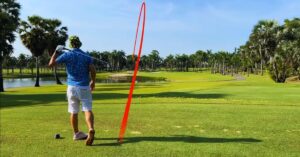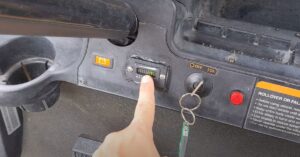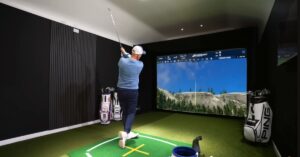Is Golf Measured In Feet Or Yards? Reveal Golf’s Unit Of Measurement
Golf is a game of precision and accuracy, and knowing the distance to the hole is essential for making the best shot. But what unit of measurement is used to measure golf distances? Is it feet or yards?
Golf distances are typically measured in yards. This is because the game of golf originated in Scotland, where the imperial system of measurement is used. However, there are some countries that use meters to measure golf distances.
In this intriguing journey through the links, we’ll explore the fascinating origins of golf’s unit of measure, the yard, and how it has become the golfer’s yardstick for success.
Difference Between Feet and Yards in Golf Holes
| Aspect | Feet (ft) | Yards (yd) |
|---|---|---|
| Length Measurement | 1 foot | 1 yard |
| Conversion Factor | 1 foot = 0.3333 yards | 1 yard = 3 feet |
| Common Usage | Short distances, putting | Longer distances, hole lengths |
| Golf Hole Lengths | Typically measured in feet for precision | Typically measured in yards for convenience |
| Example | A putt might be 5 feet long | A par-4 hole might be 400 yards long |
| Unit Symbol | ft | yd |
Please note that golf courses may use either feet or yards to measure hole lengths, but yards are more commonly used for longer holes and for expressing the total length of a golf course. Feet are often used for measuring shorter distances on the putting green and for precise measurements in situations like reading yardages for approach shots.
How Do They Measure Golf Hole Distance?

Golf hole distance is typically measured in yards. Understanding how this measurement is done is crucial for players and enthusiasts alike. Let’s delve into the methods used to measure the distance of golf holes accurately.
Using A Measuring Wheel
Measuring wheels are commonly employed to determine the distance from the tee to the hole. Groundsmen or course officials roll the measuring wheel along the fairway, capturing the exact distance. This method ensures precision and is commonly used during course setup and maintenance.
Gps Technology
Modern technology has revolutionized golf course measurements. GPS (Global Positioning System) devices equipped with mapping software provide precise measurements for each hole. Golfers often use handheld GPS devices or smartphone apps to determine yardages, factoring in any obstacles and hazards.
Laser Range Finders
Laser range finders have become increasingly popular among golfers. These handheld devices use laser beams to accurately measure the distance to the hole. Players can simply point the device at the flagstick to get precise yardage, even factoring in slopes.
Course Markers
Golf courses often have distance markers placed at various points along the fairways. These markers indicate the remaining yardage to the green from that specific location. Golfers use these markers to estimate distances and plan their shots accordingly.
Golf Course Maps
Detailed course maps are available at most golf courses, providing essential information about each hole, including yardage. Players can refer to these maps to strategize their gameplay and understand the layout of the course.
Golf Gps Watches
Golf GPS watches have gained popularity for their convenience and functionality. These wrist-worn devices not only display the time but also provide yardage to the front, back, and center of the green. Some advanced models even account for hazards and doglegs.
Online Course Mapping Services
Various online platforms offer interactive course maps with hole distances. Golfers can use these services to study the course in advance, enabling better decision-making during the game.
Distance Markers On The Green
Once golfers reach the green, they may find distance markers on the flagstick or nearby indicating the distance to the hole. This helps players accurately gauge the remaining yardage for their putts.
Caddie Input
Professional golfers often rely on their caddies to provide them with precise yardages. Caddies use a combination of tools, such as laser range finders and course knowledge, to offer valuable distance-related advice.
Tournament Measurements
During professional tournaments, golf course officials and referees ensure accurate hole measurements before play begins. This process guarantees fairness and consistency throughout the competition.
What Equipment Can You Use To Measure Golf Course Distances?

Golf is typically measured in yards, with distances playing a crucial role in the sport. Accurate measurement is essential for players to strategize their shots effectively. Fortunately, various equipment options are available to help golfers precisely gauge distances on the course.
Golf Rangefinder
Golf rangefinders are electronic devices that use laser technology or GPS to determine the distance between the golfer and specific points on the course.
They offer precise readings, allowing players to identify the distance to the flag, hazards, or other landmarks.
Some rangefinders even provide slope-adjusted distances, factoring in elevation changes for more accurate shot planning.
Gps Golf Watches
GPS golf watches are wearable devices specially designed for golfers. These wristwatches utilize satellite technology to map and measure distances on the golf course.
They provide real-time data about yardages to the front, middle, and back of the green, as well as distances to hazards. Some models offer shot tracking and performance analysis features too.
Golf Gps Apps
For those who prefer to use their smartphones, numerous golf GPS apps are available. These apps use GPS technology to map the course and display yardages. They often include additional features such as digital scorecards, shot tracking, and detailed course information.
Golf Course Markers
Most golf courses have markers strategically placed throughout the fairways to indicate distances. These markers are typically color-coded and may be positioned at 100, 150, and 200 yards from the center of the green.
Players can use these markers to estimate their remaining distance to the green and plan their shots accordingly.
Golf Course Guidebooks
Guidebooks or course guides provide detailed information about each hole on the golf course. They often include yardage charts and descriptions of various landmarks, bunkers, and hazards.
While not as dynamic as electronic devices, these guides can be helpful for pre-round planning and familiarizing oneself with the course layout.
Golf Ball Launch Monitors
Advanced players and professionals sometimes use golf ball launch monitors during practice sessions.
These sophisticated devices use radar or camera technology to analyze the ball’s flight and provide data on distance, ball speed, launch angle, and more.
While not commonly used on the course, launch monitors aid in refining swings and understanding shot distances.
Golf Course Mapping Services
Some online services provide comprehensive golf course maps with detailed measurements and aerial views.
These services can be accessed through websites or mobile apps, offering golfers valuable insights into the course layout and distances before arriving at the venue.
Are Distance Measuring Devices Legal In Golf?

Golf is a sport that requires precision and accuracy, making distance measuring devices a valuable tool for players. However, their use in golf raises questions about fairness and the integrity of the game.
Let’s explore the regulations and considerations surrounding the legality of distance measuring devices in golf.
Regulations On Distance Measuring Devices
In recent years, golf’s governing bodies have updated their rules to accommodate modern technology.
Both the United States Golf Association (USGA) and the Royal and Ancient Golf Club of St Andrews (R&A) have made provisions for distance measuring devices in their rulebooks.
According to Rule 4.3a(1) of the Rules of Golf, players are allowed to use distance measuring devices that measure only distance. Devices that gauge other factors such as wind speed, slope, or elevation are still prohibited.
Gps Devices
GPS (Global Positioning System) devices are widely used in golf and are generally permissible under the rules. These devices use satellite technology to provide accurate distance measurements to various points on the golf course.
Golfers can obtain precise yardages to the front, middle, and back of the green, as well as key hazards and landing areas.
Laser Rangefinders
Laser rangefinders have become increasingly popular among golfers due to their ease of use and accuracy. These handheld devices use lasers to determine the distance to a specific target on the course.
Golfers can aim the rangefinder at the flagstick or other objects and instantly receive yardage readings. As long as the laser rangefinders do not have slope measurement capabilities, they are permitted for use in most golf competitions.
Smartphone Apps
With the proliferation of smartphones, there are now numerous golf-related applications available that offer distance measuring features.
These apps utilize GPS technology within the phone to provide yardages and course information. However, golfers must ensure that the app they are using complies with the rules and only measures distance.
Local Rules And Tournament Specifics
While distance measuring devices are generally allowed, it is essential to check for any local rules or specific tournament regulations that might prohibit their use.
Organizers may choose to disallow distance measuring devices in certain events, especially in professional competitions, to preserve the traditional spirit of the game.
How to Avoid Confusion When Measuring Golf Holes in Feet or Yards
To avoid confusion when measuring golf holes in feet or yards, it’s essential to understand how golf holes are typically measured and the units used in different contexts:
- Standard Measurement: Golf holes are commonly measured in yards, not feet. This is the standard unit of measurement for the length of holes on a golf course. Yardage is used for course design, scorecards, and general play.
- Pin Sheets: When playing golf, you may receive pin sheets that provide the yardage to the hole’s center, front, and back. Always refer to these measurements in yards for accuracy on the course .
- As-the-Crow-Flies: Golf holes are measured “across the ground” using the playing route that most golfers will take. This accounts for the actual path golfers need to follow on the course, especially on dogleg holes.
- Hole Diagrams: Pay attention to diagrams or maps of the golf course that show the layout of each hole. These diagrams often include yardage measurements to various points on the hole.
- Distance Markers: Golf courses usually have distance markers at various points, such as tee boxes, fairways, and greens. These markers are in yards, making it easy to gauge your distance during play.
- Online Resources: Many golf-related websites and apps provide hole-by-hole information, including yardage, to help you plan your shots accurately.
- Ask the Pro: If you’re ever unsure about the hole’s measurements, don’t hesitate to ask the golf course’s professional staff for clarification.
By keeping these points in mind and using yardage as the standard unit of measurement, you can avoid confusion when measuring golf holes and make more informed decisions on the course.
Frequently Asked Questions
If you’re new to golf or just curious about the units used in this wonderful game, we’ve got you covered with clear and concise answers to the most common FAQs about golf measurements.
How Is Golf Distance Measured?
Golf distance is measured in yards. From the tee box to the hole on the green, all distances on the golf course, including fairways, hazards, and greens, are marked and measured in yards.
Why Are Yards Used Instead Of Feet?
Yards are traditionally used in golf because they provide a more convenient scale for measuring the longer distances on a golf course. Using feet for such large distances would lead to unwieldy numbers.
What About The Short Game And Putting?
Even for the short game, distances are measured in yards. Golfers use yardage markers or GPS devices to gauge the distance to the hole accurately.
Can I Use Feet On The Driving Range?
While you might see some driving ranges with distance markers in feet, it’s not common. Most driving ranges also use yards, aligning with the standard measurement unit used on the golf course.
Are There Any Exceptions To Using Yards?
Some golf courses may have distances marked in both yards and meters to accommodate international players. However, yards remain the primary unit of measurement in golf.
How Does This Affect Club Selection?
Understanding the distance in yards is essential for club selection. Golfers choose their clubs based on the yardage needed to reach the target, factoring in their individual skill level and environmental conditions.
Can I Use Other Units On The Golf Course?
While yards are the standard, you can use other units for personal reference. Just keep in mind that most golf courses and tournaments will provide distances in yards, so it’s best to get familiar with this unit for consistent play.
Conclusion
Golf distances are typically measured in yards, a unit that has been widely used in the sport since its origins in Scotland. Golfers have access to various equipment, such as GPS devices and rangefinders, to accurately gauge distances on the course, aiding in shot selection and improving gameplay.


![How To Reset Golf Cart Battery Meter? [5 Easy Steps] how-to-bypass-solenoid-on-golf-cart-1](https://giftedgolfers.com/wp-content/uploads/2023/06/how-to-bypass-solenoid-on-golf-cart-1-300x157.jpg)

![How To Hang Golf Towel With Hole In Middle? [Complete Guide] how-to-hang-golf-towel-with-hole-in-middle](https://giftedgolfers.com/wp-content/uploads/2023/06/how-to-hang-golf-towel-with-hole-in-middle-300x157.jpg)

